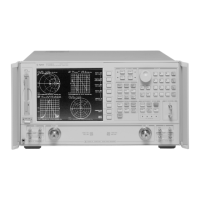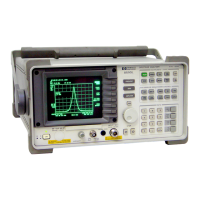Is it better to calibrate with the pulse modulator biased
on continuously or, should it be pulsing, as it will be dur-
ing the measurement? In general, it is best to calibrate
with the modulator pulsing as it will be during the meas-
urement whenever possible. This eliminates one of the
variables in the measurement. However, there are some
exceptions.
For low PRF measurements using pulse-profile mode,
the modulator should always be biased on (not pulsing)
during calibration. If it is pulsing, the error correction
algorithm in the network analyzer will overcompensate
when the pulse is on. This defeats the purpose of pulse
profiling.
For low PRF measurements using point-on-pulse
mode, there is no noticeable difference between the two
methods, provided the proper trigger setup time is
observed. In this mode the analyzer is only sampling
when the pulse is on.
For high PRFs, the only difference between the two
methods for transmission measurements is that calibrat-
ing with the pulse modulator pulsing eliminates pulse
desensitization. However, there is an equivalent rise in
the noise floor, so that there is no net gain in the dynam-
ic range. For high PRF reflection measurements, it is
important to have the modulator pulsing, so that the
directivity term in the error correction array does not
contain values so large that they mask the response of
the DUT under pulsed conditions.
Note that all three cases are still subject to the require-
ments dictated by the placement of the pulse modulator,
and that in some cases reflection measurements may not
be possible under pulsed conditions.
Conclusion
The 8720ES and 8753ES have not generally been consid-
ered capable of pulsed measurements. However, if the
pulse width is wider than 1 millisecond, or the duty
cycle is greater than .001, it is possible to make many
types of pulsed measurements with a good degree of
accuracy and repeatability using these instruments.
Optional analyzer features such as an external source
loop make them capable of an even wider range of meas-
urements, and also make available the accuracy of two-
port error correction.
The major advantage of using these analyzers instead of
more specialized pulse analyzers such as the 85108A is
their relatively low cost. The main disadvantage of these
instruments for pulsed measurements is that they use
narrowband detection. This makes them too slow to
respond to very narrow pulses when operating in the low
PRF mode, and it also means they must sacrifice dynam-
ic range in order to measure low duty cycles when oper-
ating in the high PRF mode. A secondary disadvantage
of the instruments described in this application note is
that they compare a pulsed measurement channel to a
nonpulsed reference. This tends to increase trace noise,
particularly for phase measurements.
In general, the 8720ES and 8753ES are best suited for
pulsed transmission measurements at a PRF between 20
Hz and 2 MHz. Reflection measurements are possible if
the pulse is wide enough to allow external triggering, or
if the pulse modulator can be inserted in the signal path
ahead of the reflection coupler. With some ingenuity and
a basic understanding of the underlying phenomena,
many types of pulsed measurements have been demon-
strated to be feasible.
11

